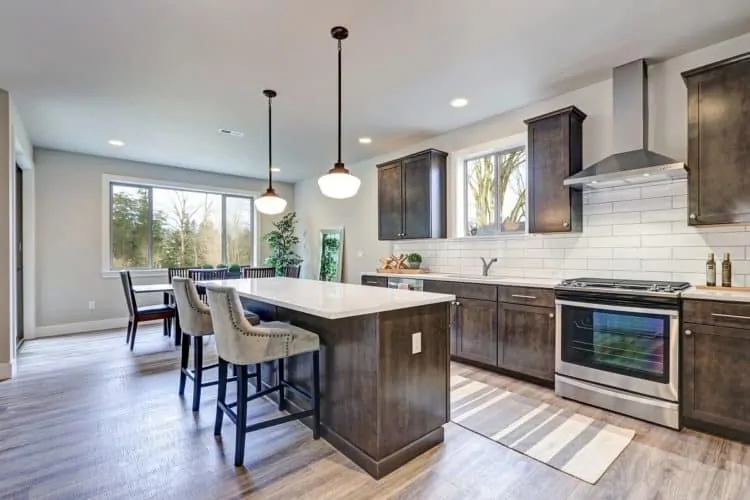
Kitchen Wall Backsplash Basics
If you want to update the backsplash in your kitchen, the good news is there are literally thousands of options you can choose from. The bad news is: this many options can be incredibly overwhelming! And unless you are an interior designer or already have a very strong sense of the kind of backsplash you want, it can be tough to know how to begin your perfect backsplash search. Here are tips for choosing the right design for your kitchen wall backsplash.
What is a Kitchen Backsplash?
Having a backsplash in your kitchen isn’t just an aesthetically pleasing choice – backsplashes serve an important protection purpose as well. As the name implies, backsplashes protect your kitchen walls and surrounding decor in the highly-used areas if your kitchen: namely the stove and the area immediately surrounding the stove, like the back wall. Therefore, the most important feature of a backsplash is that it must actually be resistant to the food and other substances that could be splashed on it. Backsplashes are truly a merge of both design and function in the home.
While there are many different material options for backsplashes, the most common choice is tile, due to its durability and water-resistant qualities. Similar to how you would use tile in bathroom flooring (including sealing it with waterproof grout), you would also use and install backsplash tile behind your stove. In addition, tile (specifically ceramic tile, which is the most popular kind) is easy to clean. When you wipe down your countertops, you can simply reach back behind the stove and wipe down the backsplash as well!
While wall tiles are the clear material frontrunner for a decorative backsplash, followed by glass and even porcelain, in recent years, other alternative materials have become popular as well. For example, natural stone has become a popular choice for homeowners looking for a water, grease and fire-resistant backsplash. It also gained popularity since it’s a natural material and easily found in the world, making it a favorite for sustainable home-builders and engineers. Another newly popular kitchen backsplash material is stainless steel. Whether you make a mosaic kitchen tile backsplash or a simple chevron design, you are bound to improve the look of your cooking space with just this simple home improvement.
Regardless of material and function, one thing is clear about backsplashes: they have become a true focal point in today’s kitchen designs, with homeowners realizing that a unique, beautiful backsplash can really make a statement. Though they may not take up much room, a beautiful backsplash can pack a design punch.
How to Choose Your Perfect Tile Backsplash Design
With the rise in alternative material choices, in addition to the many different color and style options available, choosing a backsplash design can be a tough task. Follow these steps to make the process as easy as possible, and help you choose the perfect design for your home.
Determine Your Budget
One of the first things you should do in the early stages of selecting your backsplash design is to get an idea of your budget: how much you’re willing to spend to redo and create your perfect backsplash. The good news is, as far as renovation projects go, installing a new backsplash is a fairly simple. To find out how much a kitchen tile backsplash costs, we recommend talking to your contractor and getting direct estimates for your specific project and needs.
According to Fixr.com, the average cost of installing a glazed ceramic tile backsplash that covers 16 square feet in the kitchen ranges between $400 to $600. This sample cost includes the cost of the tile itself, the cost of mortar and sealant, and the cost of hiring someone to complete the work for you. Although you probably could install your new backsplash on your own, it’s actually very technical work that requires a bit of artistry. You are much better off hiring a professional to install your backsplash, especially since the cost of labor is reasonable.
Of course, this cost will increase if you have a significantly larger backsplash space, if you choose a more expensive tile or backsplash material option, or if you want to do any sort of custom work in your backsplash. Take all these factors into account, and come up with a figure you are comfortable spending. Doing this legwork early on and setting a clear budget with your team will help prevent headache and hassle down the road.
Research Design Inspiration
Once you have an idea of how big your backsplash area is, and how much you’re able to invest in your project, it’s time to do some creative research. With the popularity of online decor inspiration sites and platforms like Pinterest, there’s no shortage of design ideas out there for you to discover. Our recommendation is to start broad – use traditional search in addition to social media platforms (which often show more trendy and recent designs) to broaden the scope of design inspiration you seek out.
Ultimately you are looking for designs that resonate with you and your home – not just backsplash designs that look cool online or are “the it trend” of the moment. Start to save pictures and example kitchens that jump out at you. And don’t be afraid to think (or look) outside the box! The backsplash in your kitchen is a design area where you can choose to get a little more creative than you normally would.
Note Your Existing Decor
In addition to doing visual research on backsplash inspiration, make sure that you also take note and factor in your existing kitchen design. Your new backsplash should accentuate your current kitchen, and make a big impact through a relatively small change. So, take a look at the general layout of your kitchen, and ask yourself the following questions:
-What color are your walls?
-What color are your cabinets?
-What material/color are your countertops?
-What do your appliances look like?
-What’s your general design aesthetic of your current kitchen?
Unless you want to do a full-scale kitchen remodel (which is an option as well), you’re much better off working in harmony with your existing design elements, and finding a backsplash design that will complement your current decor. You can certainly uplevel or experiment with your new backsplash design – it may be a great way to test the waters for a new style of decorating you want to apply to your whole kitchen.
Above any other factor, make sure you consider your countertops. Your countertops are an expansive part of your kitchen, and your backsplash is going to jut right up against your countertop material. So, it’s imperative to make sure the materials and colors of your backsplash and countertops work well together. If your countertops are neutral, you will have a little more flexibility on which direction you can go with your backsplash, but still, choose wisely.
Determine Your Aesthetic
Once you’ve noted any current prominent design in your kitchen, you’ll be able to make a congruent decision on the desired aesthetic of your backsplash. Does your kitchen have a dark-hued modern vibe, with metallic appliances? Is your kitchen rather bright, and airy, maybe even soft and feminine? Is “classic” the first world you’d use to describe your kitchen? Take note of prominent design elements, and think of how you can choose a backsplash that complements them.
Or perhaps, you’re looking to use your new backsplash as a way to revamp your aesthetic. A blue-toned, oceanic backsplash can easily turn a classic white kitchen into a beachside-ready haven. Whether you’re going to use your backsplash to emphasize your current aesthetic, or test out a new one, be sure you have a direction in mind. Lack of clarity here will lead to an underwhelming final product, and no one wants that!
Determine Your Color Palette
In addition to determining aesthetic, determining your color options is a choice you’ll have to make fairly early on in the design ideation process. And one of the biggest questions you’ll encounter as your determining your new backsplash design is: color or neutral? You will have to decide whether you want your backsplash to be colorful, or remain either white or neutral. A pop of color will of course make a more pronounced impact, as a “statement” piece, but a neutral backsplash can also provide character.
Again, take a look at your current kitchen design. Do you have white cabinets and countertops? If so, then either colored backsplash option will work for you. A white backsplash (perhaps in the popular white subway tile) will create an open, bright aesthetic, but with a neutral existing palette, you’ll also be primed for a brightly colored backsplash.
Determine Materials
Once you have a handle on color palette, aesthetic, and overall look and feel, you can start to refine your selection for materials. As mentioned above, ceramic tile is easily the most popular and common backsplash material option, but there are many alternative materials to choose from today.
In addition to alternative materials like stainless steel and natural stone, there are other unique options, such as brick or manipulated wood. Similar to some of the wood flooring alternatives that have developed in recent years, there are also backsplash options that mimic the look and feel of real wood, without the malleability. Wood substitute backsplashes create a rustic, unique look, but still offer the benefit of easy cleanup and waterproof resistance. A brick backsplash would also create a rustic (or industrial) aesthetic.
Even if you want to go with the classic option of ceramic tile, you have wiggle room for how you use it. You can create a truly unique custom creation with hand-painted tile, or mix and match a few complementary styles together.
Determine Size
There are many ways you can customize your kitchen backsplash and create your perfect design, but one element that’s often overlooked is the size of your backsplash. Yes, you will have to cover the minimum area around your stove and cooking surface, but you don’t necessarily have to stop there. You can craft your perfect backsplash design by thinking outside the box in terms of size and scope. You can extend the height of the backsplash up the back wall, perhaps even to the ceiling. Or, you can go for an extreme look and cover the entire wall where the backsplash exists with your chosen backsplash pattern. With this approach, your backsplash becomes more of an accent wall than a small focal point. And depending on your chosen material, this may be exactly what you’re looking for.
Finalize Any Custom Touches
Even if you’re using a store-bought tile, or opting for one singular material, you still have some room to customize your backsplash so it’s 100 percent unique to you and your home. For example, you can take a traditional tile, and install it in a unique pattern, like chevron or harlequin diamonds. Or you can add in a signature tile piece, like a calling card, to make your backsplash truly personalized. Or if you’re feeling especially brave, you can DIY create your backsplash tile. Just purchase plain ceramic tile and paint away.
One note about custom backsplashes: with any design you are considering, make sure that you thoroughly layout the tile and are able to envision what it will look like once it’s up on your wall. Especially if you’re pursuing a very unique and different design, spend some time making sure you like what you see. While backsplashes aren’t necessarily hard or time-intensive to install, it’s not a process you want to have to do over. Having to redo your backsplash is a waste of time, money, and emotional investment, so do some in-depth thinking ahead of time to prevent it from happening.
When it comes to your kitchen backsplash, even though the surface area of this design element is relatively small, you can see how it makes a large impact. You can make a statement with your backsplash through a pop of color and unique design, or you can opt for something more classic, timeless, and understated. The important thing is that you choose a design that feels authentic to you. Your home is a representation of the things that you and your family love. Choose a tile backsplash design that feels like home, and turns your kitchen into even more of an extension of your unique home life.











